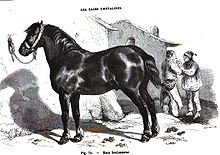
The Percheron is a breed of draft horse that originated in the Huisne river valley in western France, part of the former Perche province, from which the breed takes its name. Usually gray or black in color, Percherons are well-muscled, and known for their intelligence and willingness to work. Although their exact origins are unknown, the ancestors of the breed were present in the valley by the 17th century. They are believed to descend from war horses. Over time, they began to be used for pulling stagecoaches; and later, for agriculture and hauling heavy goods. In the late 18th and early 19th centuries, Arabian blood was added to the breed. Exports of Percherons from France rose exponentially in the late 19th century, and the first purely Percheron stud book was created in France in 1893.

The Ardennais or Ardennes is one of the oldest breeds of draft horse, and originates from the Ardennes area in Belgium, Luxembourg, and France. They are heavy-boned with thick legs and are used for draft work.

The Trait Breton is a French breed of draught horse. It originated in Brittany, in north-west France, from cross-breeding of local horses with various other breeds. It is strong and muscular, and often has a chestnut coat.

The Auxois is a horse breed from eastern France. It is a large breed, with some individuals weighing over 910 kilograms (2,010 lb), bred for horse meat, agricultural work and leisure pursuits. Overall, members of the breed are solid and muscular in appearance. They are usually bay or bay roan in color, although some other colors are accepted by the breed registry, and are known for their power and docility.

The Trait du Nord, previously also known as Ardennais du Nord or Ardennais de type Nord, is a breed of heavy draft horse developed and bred in the area of Hainaut in western Belgium and in northeastern France. Originally considered a subtype of the Ardennes, it was recognized as an individual breed with the opening of a studbook in 1903. Developed in the fertile Flemish grasslands, it was bred for size and pulling power for agricultural work. By 1855, the horses bred near Hainaut were considered by some veterinarians to be superior to other Flemish draft breeds. The Trait du Nord was used extensively in mining from the late 19th century through 1920, with lesser use continuing through the 1960s.
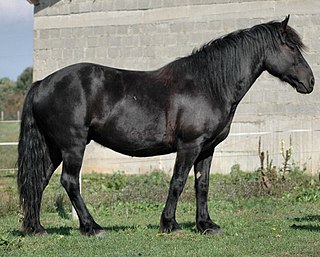
The Mérens, Cheval de Mérens or Caballo de Merens, still occasionally referred to by the older name of Ariégeois pony, is a small, rustic horse native to the Pyrenees and Ariégeois mountains of southern France, where the river Ariège flows, and northern Spain, near Andorra. Two general types, a small, light traditional mountain horse and a taller, sportier modern type, are found. Always black in color, Mérens must meet strict physical standards in order to be registered in the stud book. The breed is known for its sure-footedness on mountain terrain, as well as for its endurance, hardiness and docility. The French breed registry organizes regional offices, and partners with other national organizations in Europe to preserve and promote the breed. The organization enforces rigorous selection of breeding stock, with a goal of increasing quality in the breed. In the past, the Mérens was used for farm work, draft work and as pack horses. Today it is mainly used as a saddle horse, although some members of the breed have been successful in carriage driving. Many Mérens are taken on an annual transhumance, in which they are moved higher in the mountains during the summer and into the valleys for the winter. An old practice, it fell into disfavor, but has recently re-emerged.

The Poitevin or Poitou is a French breed of draft horse. It is named for its area of origin, the former province of Poitou in west-central France, now a part of the region of Nouvelle-Aquitaine. It was formed in the seventeenth century when horses of Flemish or Dutch origin, brought to the area by engineers working to drain the Marais Poitevin, interbred with local horses. Although it has the size and conformation of a draft horse, the Poitevin has never been bred for draft abilities, and has been little used for draft work. Its principal traditional use was the production of mules. Poitevin mares were put to jacks of the large Baudet du Poitou breed of donkey; the resulting Poitevin mules were in demand for agricultural and other work in many parts of the world, including Russia and the United States. In the early twentieth century there were some 50,000 brood mares producing between 18,000 and 20,000 mules per year.

The Anglo-Norman horse is a warmblood horse breed developed in Lower Normandy in northern France. A major center of horse breeding, the area had numerous regional types that were bred to one another and then crossed with Thoroughbreds to form the Anglo-Norman. Various body types developed within the Anglo-Norman breed, two of which were split off to form the Norman Cob and French Trotter. The remaining types were eventually standardized, although there remained some criticism of the "hybrid" nature of the breed's conformation. However, it is successful as an international sport horse, especially in the sport of show jumping. The Anglo-Norman also contributed to the development of several other breeds in Europe and Asia.

The Norman Cob or Cob Normand is a breed of light draught horse that originated in the region of Normandy in northern France. It is of medium size, with a range of heights and weights, due to selective breeding for a wide range of uses. Its conformation is similar to a robust Thoroughbred, and it more closely resembles a Thoroughbred cross than other French draught breeds. The breed is known for its lively, long-striding trot. Common colours include chestnut, bay and seal brown. There are three general subsets within the breed: horses used under saddle, those used in harness, and those destined for meat production. It is popular for recreational and competitive driving, representing France internationally in the latter, and is also used for several riding disciplines.
The Cheval du Morvan, also known as the Morvandiau, Morvandain or Morvandelle, is an extinct French horse breed from the Morvan massif in Burgundy, for which it is named. Horses were bred in the Morvan from before the French Revolution, both as saddle-horses for fox-hunting and as cavalry mounts, and for draught use. They were of small to medium height and known for their strength and tenacity. The Cheval du Morvan became extinct with the advent of industrialisation and improved transportation in the nineteenth century. As a draught horse it was replaced by the Nivernais and Comtois breeds, and as a saddle-horse by the Thoroughbred.

The Cauchois, also known as the Norman bidet, is a breed of heavy draft horse native to the Pays de Caux, on the coast of the former Haute-Normandie region of France. Valued for its strength and ability to move at a high pace, the Cauchois was especially sought after during the 17th and 18th centuries. These horses were primarily used for hauling heavy loads, including the stagecoaches operated by the Compagnie Générale des Omnibus, but they were also ridden by local peasants to transport goods to market.

The Norfolk Phœnomenon is a black-coated stallion of the Norfolk Trotter breed. He is a son or grandson of the most famous English trotter stallion of his time, The Norfolk Phenomenon. He was imported to France in 1851 on a mission from the Haras Nationaux.

The Breton bidet is a type of bidet, a small horse bred in Brittany. Characterized by its ability to move at amble, and bred for its working strength, the bidet has been around since the 5th century. In the Middle Ages, it may have been crossed with oriental horses brought by the House of Rohan. Widespread in Brittany until the mid-nineteenth century, bidets were used for all work requiring a low-value horse. The Haras Nationaux fought against this breeding. Transportation modernized in the 19th century, making the draft horse more sought-after. The Breton bidet disappeared at the dawn of the 20th century.

The Corlay horsebreed is a type of half-blood horse resulting from crossbreeding around the town of Corlay in Brittany, between local Breton bidet mares and imported stallions, primarily Thoroughbreds. Intended for racing, this variety of Breton horse is reputed to have impressed Napoleon III with its steeplechase abilities. As a result, local breeders specialized in this racehorse, optimizing its feed by adding maerl to the diet. Corlay horse breeding gained an excellent reputation from the mid to late 19th century. The most influential stallion in the breed was named Corlay, who bred from 1876 to 1897 in the locality of the same name. The breed was considered established by the end of the century.
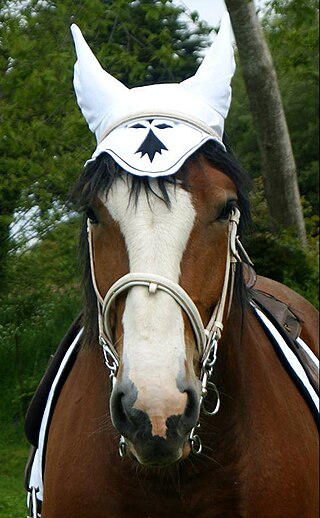
Horses in Brittany have a clear historical, economic and cultural importance, since their introduction often attributed to the Celts. In Brittany, the horse, generally a Breton bidet, was mainly used as a saddle animal until the middle of the 19th century. As roads improved, most breeders specialized in draft horses and carriage horses. They mainly settled in the west, in Basse-Bretagne, Trégor and Léon. The Breton draft horse, a renowned working animal, was exported in large numbers from Landivisiau in the early 20th century.
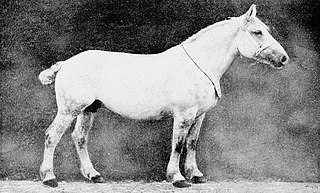
The Trait du Maine is an extinct draft horse breed originating from the region of Maine in northwestern France. Bred from the 1830s onwards by crossing mares from Mayenne with Percheron stallions, it had its own studbook due to the Percheron Horse Society refusing to include horses born outside of the Perche region. The Trait du Maine was officially recognized as a horse breed in 1926 and had up to 25,000 annual births in 1929. These horses were mainly exported to the agricultural regions of Beauce, France and Spain. In 1966, the Trait du Maine merged their studbook with the Percheron breed, which absorbed it, leading to the elimination of the Trait du Maine as a distinct breed.
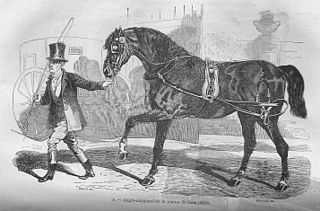
The Carrossier noir du Cotentin is a large, black, pulling horse breed unique to Cotentin. It was regularly described and quoted during the Ancien Régime and may have descended from Danish horses. As its name suggests, this horse was mainly used to pull carriages, and its uniform color made it possible to form homogeneous groups.

The Merlerault is a formerly common breed of horse that originated in the canton of Le Merlerault. Bred under the Old Regime, this reputedly elegant half-bred was used to ride and pull tilburys.

A meat horse, or slaughter horse, is a horse bred for its ability to yield meat. Coming from draft horses formerly used for agricultural work, these horses are threatened with extinction by the mechanization of agricultural activities. This state of affairs has prompted breeders to look for new economic outlets. Breeding for meat horses was very popular in France in the 1980s, helping to safeguard these breeds. It has developed in Italy and Spain, but is declining in France, due to the further reduction of work activities with draft horses.

Prince Chaldean is a Percheron gray stallion, known for his very long, abundant mane. Born in the Perche region of France in 1877, he was exported as a youngster to the United States, where he was briefly owned by Mark Wentworth Dunham, who sold him a few months later to Mr. Babcock in Wisconsin. Chaldean became a popular local breeding stallion.



